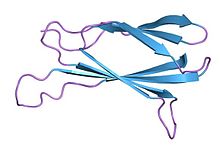Monobody

Monobodies are synthetic binding proteins constructed using a
Monobodies are generated from
Monobodies belong to the class of molecules collectively called antibody mimics (or antibody mimetics) and alternative scaffolds that aim to overcome shortcomings of natural antibody molecules. A major advantage of monobodies over conventional antibodies is that monobodies can readily be used as genetically encoded intracellular inhibitors, that is you can express a monobody inhibitor in a cell of choice by simply transfecting the cell with a monobody expression vector.[9][10] This is because of the characteristics of the underlying FN3 scaffold: small (~90 residues), stable, easy to produce, and its lack of disulfide bonds that makes it possible to produce functional monobodies regardless of the redox potential of the cellular environment, including the reducing environment of the cytoplasm and nucleus.[11] In contrast, most antibodies and antibody fragments depend on disulfide bonds formation and they must be produced under an oxidizing environment.
The monobody technology has been adopted in the biotechnology industry, most notably by Adnexus, a biotechnology company which has been part of
Structure
The native FN3 scaffold consists of 94
Monobody library designs
Monobodies with high affinity and specificity for different target molecules can be generated from combinatorial libraries in which portions of the FN3 scaffold are diversified. There are two distinct designs of monobody libraries that have been successful. The first type modifies some or all of the loops BC (between the second and third beta sheets), DE (between the fourth and fifth beta sheets) and FG (between the sixth and seventh sheets).[18][19] This design creates diversified positions on a convex surface that is suitable for targeting concave surfaces such as enzyme active sites. The second type modifies positions in some or all of the C, D, F and G (or the 3rd, 4th, 6th and 7th) strands in addition to the CD and FG loops.[20] This design creates a flatter, slightly concave surface that is suitable for targeting surfaces typically involved in protein-protein interactions.
See also
References
- PMID 9837732.
- PMID 22230568.
- PMID 22198408.
- PMID 20357770.
- PMID 21518904.
- PMID 22000011.
- PMID 23980151.
- PMID 25290819.
- PMID 22000011.
- PMID 23980151.
- S2CID 367423.
- PMID 12204693.
- ^ Clinical trial number NCT00562419 for "CT-322 in Treating Patients With Recurrent Glioblastoma Multiforme and Combination Therapy With Irinotecan" at ClinicalTrials.gov
- PMID 19576999.
- PMID 17041261.
- PMID 20357770.
- PMID 21518904.
- PMID 9837732.
- PMID 20357770.
- PMID 22198408.

